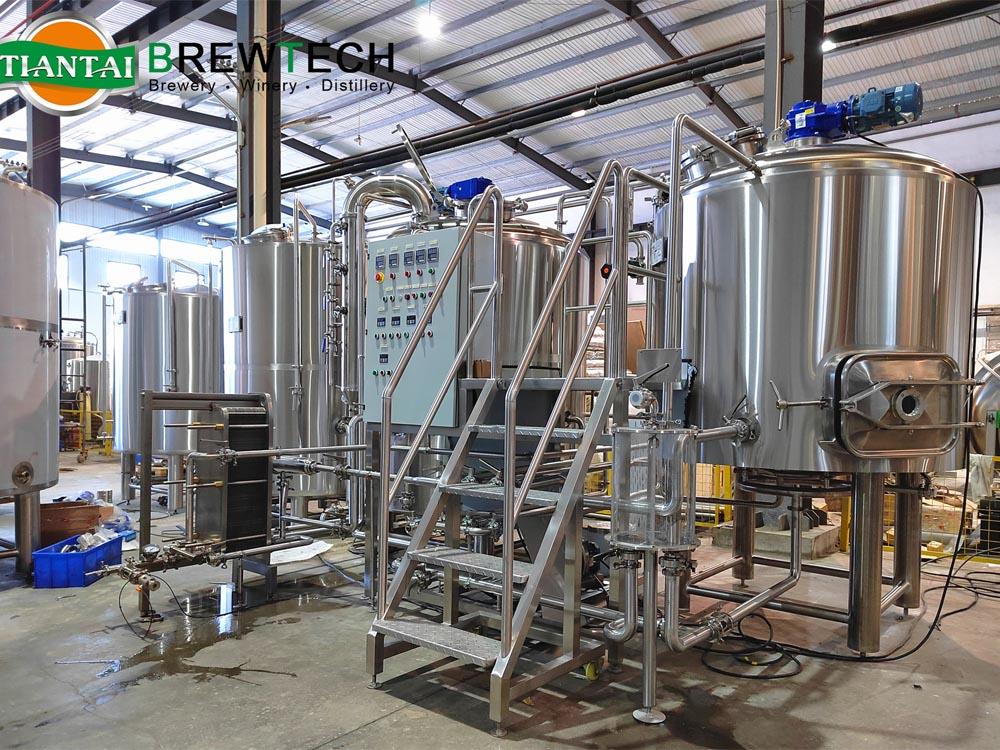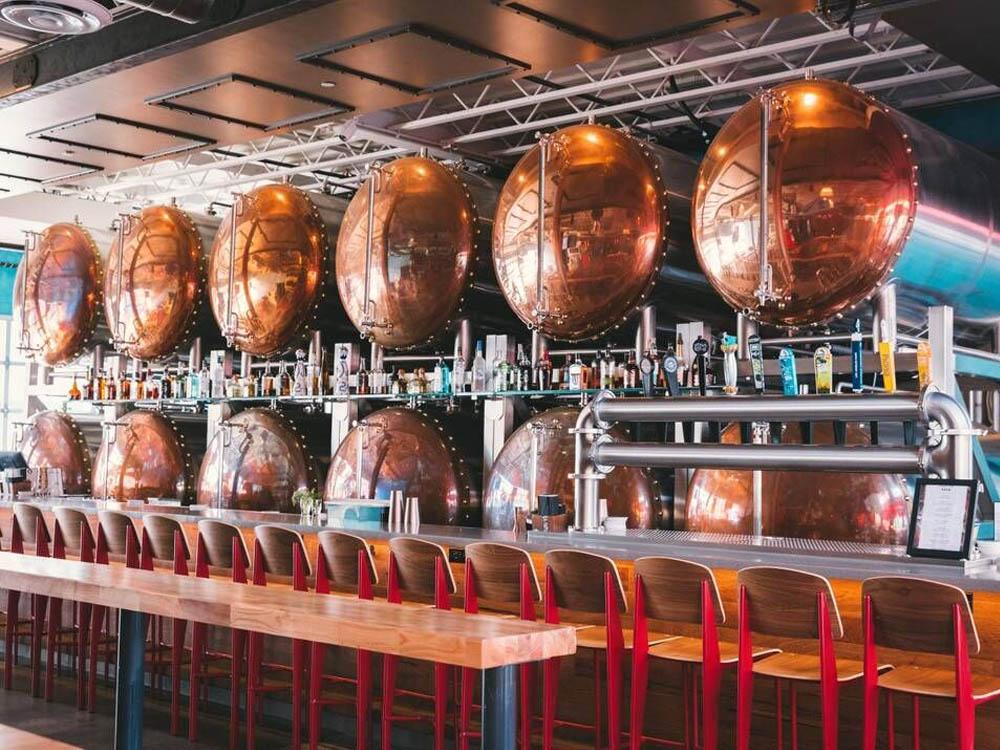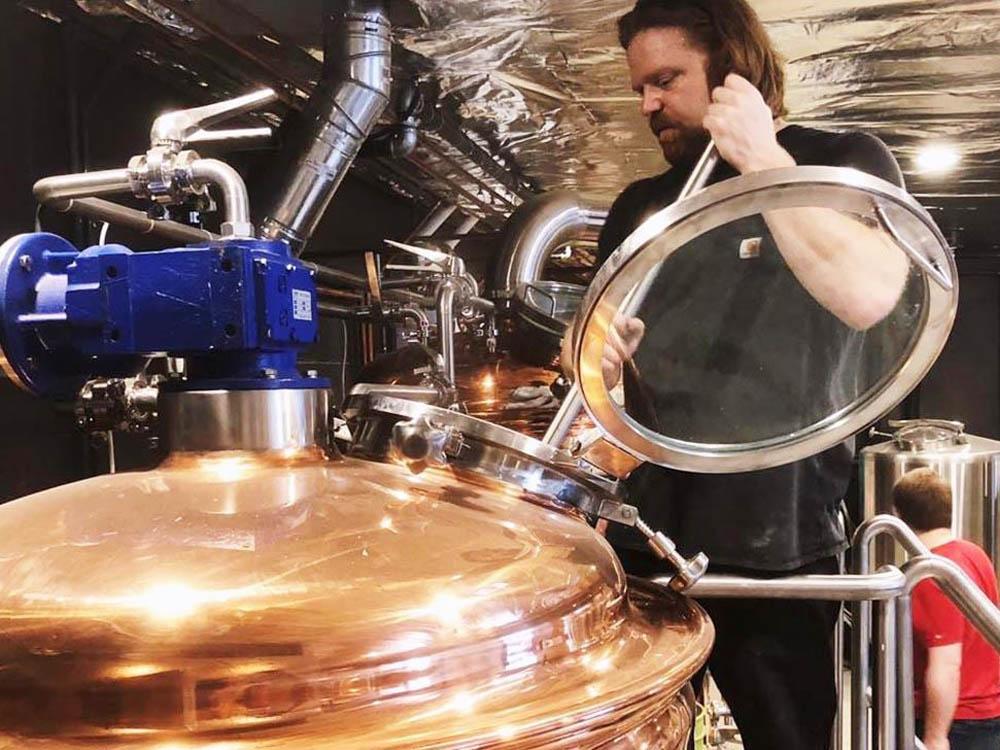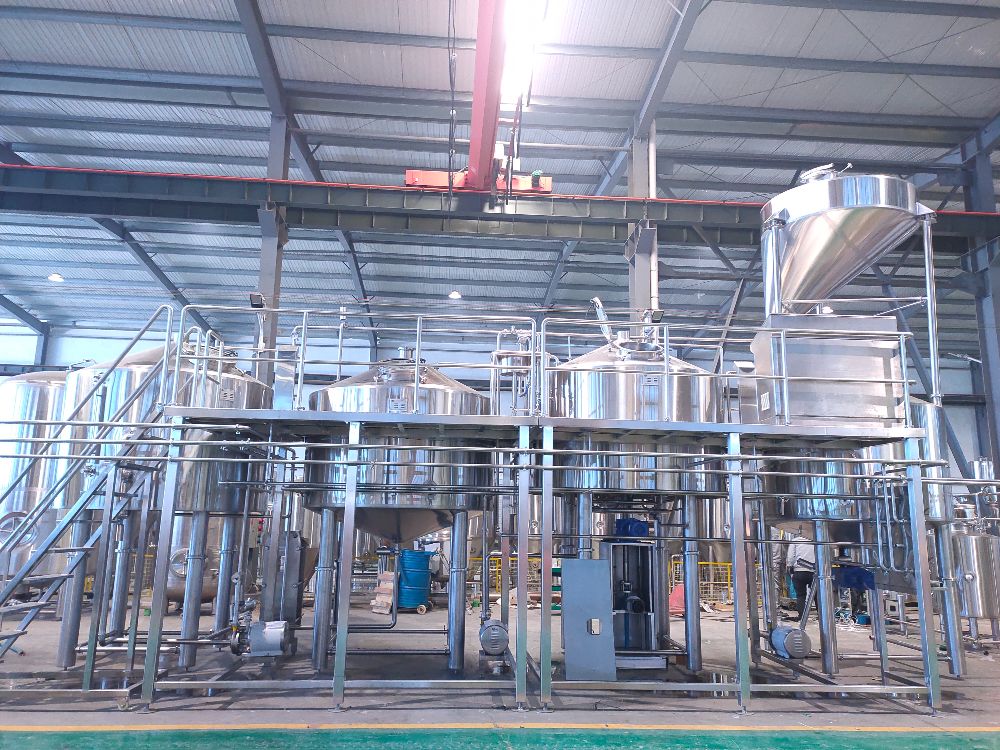Can the beer brewing equipment use copper as inner shell?
- Sep 23, 2024
- 117
- tiantai
When planning to set up a brewery, there are much information need consideration. Choosing a suitable beer brewing equipment is also very important part. So, when customize a beer brewing system, some customers usually have some questions. One very interested question is that: Except the SUS inner shell, can the beer brewing tanks choose copper inner shell? Do you also have this kind of question? If yes, let discuss this together. Cheers!
Part 1: History of using copper beer brewing equipment
The use of copper liners in beer brewing equipment can be traced back several centuries. Around the 18th and 19th centuries, copper was the main brewing equipment material for major European breweries. The following is a detailed background on the historical timeline of copper brewing equipment:
Historical period of copper liner use:
Early 18th century to mid-19th century:
In the 18th century, with the advancement of the Industrial Revolution, European breweries gradually began to scale up production. Copper's excellent thermal conductivity makes it the preferred material for brewing equipment.
During this period, almost all brewing equipment (including boiling pots, saccharification tanks, etc.) used copper because there was no better alternative material at the time, and copper's machinability also facilitated the manufacture of equipment.
Mid-to-late 19th century:
In the late 19th century, especially after the 1870s, stainless steel was not yet popular, and copper was still the most common material. Especially in traditional beer producing countries such as Germany, the United Kingdom, and Belgium, copper equipment is almost standard for brewing.
By the end of the 19th century, the design of beer brewing equipment began to gradually standardize, and the widespread use of copper equipment continued to this point.
Early 20th century:
In the early 20th century, with the development of materials science, people began to look for alternative materials that are more corrosion-resistant and less expensive than copper. The invention and gradual popularization of stainless steel (stainless steel began to enter industrial applications in the 1930s) brought revolutionary changes to brewing equipment.
By the mid-20th century (1950s), stainless steel began to gradually replace copper as the mainstream material for beer equipment. Many new breweries during this period began to fully adopt stainless steel equipment.
From the mid-to-late 20th century to the present:
After the 1970s, stainless steel became the mainstream, and copper liner equipment gradually withdrew from the actual production field and was used in display equipment or small-scale craft brewing scenes as a nostalgia and commemoration of tradition.
Summary:
Copper has been the mainstream material for beer equipment for at least 200 to 300 years, but since the mid-20th century (about 70 years ago), copper has been gradually replaced by stainless steel. Today, copper is more often used as a decorative material in brewing equipment to preserve traditional styles, but in actual production, it has mostly been replaced by more modern stainless steel materials.

Part 2: What is the merit and demerit of copper beer brewing equipment, compared to common SUS beer equipment
In the selection of beer brewing equipment, stainless steel and copper each have their own advantages and disadvantages, but stainless steel is a more widely and commonly used material. The following is a comparative analysis of the two:
Stainless steel:
Advantages:
1. Strong corrosion resistance: Stainless steel has good resistance to chemicals such as acids and alkalis, and can withstand the corrosive environment in the brewing process.
2. Easy to clean: The surface is smooth and not easy to adhere to dirt and microorganisms, which is easy to clean and maintain, ensuring the hygiene of the equipment.
3. High durability: Stainless steel is strong and durable, wear-resistant and has a long life.
4. No odor and no reaction: It will not react with the chemical components in beer, so it will not affect the taste of beer.
5. Lower cost: Compared with copper, stainless steel materials are more economical while providing good performance.
Disadvantages:
The thermal conductivity is not as good as copper, but it has less impact in the brewing process because it can be compensated by design and other heating technologies.

Copper:
Advantages:
1. Good thermal conductivity: Copper has better thermal conductivity than stainless steel, which helps to heat the wort more evenly and quickly.
2. Traditional appearance: The appearance of copper is classic and beautiful, especially in display breweries, it has high visual appeal.
Small amounts of copper ions are beneficial: Small amounts of copper ions help yeast health and can improve some flavor characteristics.
Disadvantages:
1. Corrosion: Copper is easily corroded by acidic substances, especially in the presence of wort and cleaning chemicals, requiring higher maintenance costs.
2. Difficult to clean: The copper surface is easily oxidized and difficult to keep bright, and the cleaning and maintenance workload is high.
3. Highly reactive: It may react with certain ingredients in beer, affecting the flavor of beer, especially if not properly maintained.
4. High cost: Copper has higher material and maintenance costs and requires regular polishing and maintenance.
Conclusion:
For modern beer brewing equipment, stainless steel is a better choice because it combines durability, easy cleaning and economy. Although copper has thermal conductivity advantages and aesthetics, it requires higher maintenance, and its potential reactivity and corrosion issues make it less practical than stainless steel. Therefore, stainless steel is usually a more ideal choice, especially considering food safety and long-term use costs.

Part 3: How to do daily maintainance if beer brewing equipment uses copper inner shell
If the inner tank of the beer brewing equipment is made of copper, it needs regular and meticulous maintenance to prevent corrosion and oxidation, to ensure the good condition of the equipment and the quality of the beer. Here are some suggestions for maintaining the copper inner tank:
How to maintain the copper inner tank:
1. Regular cleaning:
Soft brush and warm water: Use a soft brush and warm water to gently clean the copper surface. Avoid using steel wool or other hard brushes to prevent scratching the copper surface.
Avoid using strong acid or strong alkaline cleaners: Copper is sensitive to acidic and alkaline cleaners. When cleaning, use pH neutral cleaners to avoid corroding the surface.
2. Prevent oxidation:
Dry maintenance: Wipe the surface dry immediately after cleaning to prevent oxidation spots caused by water stains.
Oxidation treatment: If oxidation occurs on the copper surface, it can be removed with a special copper cleaner or polishing paste, but make sure that the cleaning agent is completely rinsed to avoid residue affecting the quality of the beer.
3. Regular polishing:
Copper polishing agent: Use a special copper polishing agent to maintain the gloss of the inner tank and prevent the surface from darkening. After polishing, it must be thoroughly cleaned to prevent the influence of chemical residues on the brewing process.
Polishing frequency: depends on the frequency of use. Generally speaking, polishing once a month or quarter can keep it in good condition.
4. Avoid contact with sulfides and acidic substances:
Try to avoid using sulfur-containing chemicals during brewing and avoid contact with sulfides to prevent the formation of sulfide black spots on the copper surface.
When brewing and cleaning, do not use detergents containing acid or sulfuric acid to avoid accelerating copper corrosion.
5. Monitor the copper ion content of the equipment:
Regularly test the copper ion content in beer to ensure that the flavor or health and safety of the beer will not be affected by the dissolution of copper.
6. Check the status of the equipment regularly:
Corrosion and crack inspection: Regularly check whether there is corrosion, cracks or other damage inside the equipment, and repair it in time.
Protective coating: Some equipment may use a thin layer of protective coating on the copper surface. The integrity of the coating needs to be checked regularly to prevent peeling.
Note:
Avoid over-polishing: Excessive or too frequent polishing may wear the surface of the copper material, so it should be done in moderation and at the right time.
Use food-grade cleaning supplies: Make sure all cleaning supplies used are food-grade to avoid adverse effects on the quality and safety of the beer.
Maintaining copper equipment requires more time and money, but if done properly, it can preserve the aesthetics of copper while ensuring that it does not negatively impact your brewing process.

Part 4: Reasons of the copper shell being gradually replaced by stainless steel
1. Corrosion problem
Copper easily reacts with acidic substances and corrodes, resulting in damage to the inner wall and complicated equipment maintenance.
2. Difficulty in cleaning and maintenance
Copper equipment needs to be polished regularly to prevent oxidation, which is not only time-consuming and labor-intensive, but also requires additional costs.
3. Food safety
Although copper has certain benefits for yeast, excessive dissolution of copper ions will have a negative impact on human health, and modern food safety standards tend to avoid direct contact with copper materials.
4. The advantages of stainless steel
Stainless steel has excellent corrosion resistance, is easy to clean, durable, and has no effect on the flavor of beer, so it has gradually replaced copper as the first choice in modern brewing equipment.
5. Cost and benefit
Stainless steel equipment is more cost-effective in material cost and long-term use and maintenance, which makes it the first choice for most commercial breweries.
Hope these information can help you understand better on choose of copper inner shell or SUS inner shell. Setting up a brewery needs considering much information. Welcome to contact Nicole at [email protected] for customizing your beer brewing equipment. Let us assist you in setting up a functional brewery. Cheers!
Edited by Nicole
Sales manager | Tiantai beer equipment
Email: [email protected]
Part 1: History of using copper beer brewing equipment
The use of copper liners in beer brewing equipment can be traced back several centuries. Around the 18th and 19th centuries, copper was the main brewing equipment material for major European breweries. The following is a detailed background on the historical timeline of copper brewing equipment:
Historical period of copper liner use:
Early 18th century to mid-19th century:
In the 18th century, with the advancement of the Industrial Revolution, European breweries gradually began to scale up production. Copper's excellent thermal conductivity makes it the preferred material for brewing equipment.
During this period, almost all brewing equipment (including boiling pots, saccharification tanks, etc.) used copper because there was no better alternative material at the time, and copper's machinability also facilitated the manufacture of equipment.
Mid-to-late 19th century:
In the late 19th century, especially after the 1870s, stainless steel was not yet popular, and copper was still the most common material. Especially in traditional beer producing countries such as Germany, the United Kingdom, and Belgium, copper equipment is almost standard for brewing.
By the end of the 19th century, the design of beer brewing equipment began to gradually standardize, and the widespread use of copper equipment continued to this point.
Early 20th century:
In the early 20th century, with the development of materials science, people began to look for alternative materials that are more corrosion-resistant and less expensive than copper. The invention and gradual popularization of stainless steel (stainless steel began to enter industrial applications in the 1930s) brought revolutionary changes to brewing equipment.
By the mid-20th century (1950s), stainless steel began to gradually replace copper as the mainstream material for beer equipment. Many new breweries during this period began to fully adopt stainless steel equipment.
From the mid-to-late 20th century to the present:
After the 1970s, stainless steel became the mainstream, and copper liner equipment gradually withdrew from the actual production field and was used in display equipment or small-scale craft brewing scenes as a nostalgia and commemoration of tradition.
Summary:
Copper has been the mainstream material for beer equipment for at least 200 to 300 years, but since the mid-20th century (about 70 years ago), copper has been gradually replaced by stainless steel. Today, copper is more often used as a decorative material in brewing equipment to preserve traditional styles, but in actual production, it has mostly been replaced by more modern stainless steel materials.
Part 2: What is the merit and demerit of copper beer brewing equipment, compared to common SUS beer equipment
In the selection of beer brewing equipment, stainless steel and copper each have their own advantages and disadvantages, but stainless steel is a more widely and commonly used material. The following is a comparative analysis of the two:
Stainless steel:
Advantages:
1. Strong corrosion resistance: Stainless steel has good resistance to chemicals such as acids and alkalis, and can withstand the corrosive environment in the brewing process.
2. Easy to clean: The surface is smooth and not easy to adhere to dirt and microorganisms, which is easy to clean and maintain, ensuring the hygiene of the equipment.
3. High durability: Stainless steel is strong and durable, wear-resistant and has a long life.
4. No odor and no reaction: It will not react with the chemical components in beer, so it will not affect the taste of beer.
5. Lower cost: Compared with copper, stainless steel materials are more economical while providing good performance.
Disadvantages:
The thermal conductivity is not as good as copper, but it has less impact in the brewing process because it can be compensated by design and other heating technologies.

Copper:
Advantages:
1. Good thermal conductivity: Copper has better thermal conductivity than stainless steel, which helps to heat the wort more evenly and quickly.
2. Traditional appearance: The appearance of copper is classic and beautiful, especially in display breweries, it has high visual appeal.
Small amounts of copper ions are beneficial: Small amounts of copper ions help yeast health and can improve some flavor characteristics.
Disadvantages:
1. Corrosion: Copper is easily corroded by acidic substances, especially in the presence of wort and cleaning chemicals, requiring higher maintenance costs.
2. Difficult to clean: The copper surface is easily oxidized and difficult to keep bright, and the cleaning and maintenance workload is high.
3. Highly reactive: It may react with certain ingredients in beer, affecting the flavor of beer, especially if not properly maintained.
4. High cost: Copper has higher material and maintenance costs and requires regular polishing and maintenance.
Conclusion:
For modern beer brewing equipment, stainless steel is a better choice because it combines durability, easy cleaning and economy. Although copper has thermal conductivity advantages and aesthetics, it requires higher maintenance, and its potential reactivity and corrosion issues make it less practical than stainless steel. Therefore, stainless steel is usually a more ideal choice, especially considering food safety and long-term use costs.

Part 3: How to do daily maintainance if beer brewing equipment uses copper inner shell
If the inner tank of the beer brewing equipment is made of copper, it needs regular and meticulous maintenance to prevent corrosion and oxidation, to ensure the good condition of the equipment and the quality of the beer. Here are some suggestions for maintaining the copper inner tank:
How to maintain the copper inner tank:
1. Regular cleaning:
Soft brush and warm water: Use a soft brush and warm water to gently clean the copper surface. Avoid using steel wool or other hard brushes to prevent scratching the copper surface.
Avoid using strong acid or strong alkaline cleaners: Copper is sensitive to acidic and alkaline cleaners. When cleaning, use pH neutral cleaners to avoid corroding the surface.
2. Prevent oxidation:
Dry maintenance: Wipe the surface dry immediately after cleaning to prevent oxidation spots caused by water stains.
Oxidation treatment: If oxidation occurs on the copper surface, it can be removed with a special copper cleaner or polishing paste, but make sure that the cleaning agent is completely rinsed to avoid residue affecting the quality of the beer.
3. Regular polishing:
Copper polishing agent: Use a special copper polishing agent to maintain the gloss of the inner tank and prevent the surface from darkening. After polishing, it must be thoroughly cleaned to prevent the influence of chemical residues on the brewing process.
Polishing frequency: depends on the frequency of use. Generally speaking, polishing once a month or quarter can keep it in good condition.
4. Avoid contact with sulfides and acidic substances:
Try to avoid using sulfur-containing chemicals during brewing and avoid contact with sulfides to prevent the formation of sulfide black spots on the copper surface.
When brewing and cleaning, do not use detergents containing acid or sulfuric acid to avoid accelerating copper corrosion.
5. Monitor the copper ion content of the equipment:
Regularly test the copper ion content in beer to ensure that the flavor or health and safety of the beer will not be affected by the dissolution of copper.
6. Check the status of the equipment regularly:
Corrosion and crack inspection: Regularly check whether there is corrosion, cracks or other damage inside the equipment, and repair it in time.
Protective coating: Some equipment may use a thin layer of protective coating on the copper surface. The integrity of the coating needs to be checked regularly to prevent peeling.
Note:
Avoid over-polishing: Excessive or too frequent polishing may wear the surface of the copper material, so it should be done in moderation and at the right time.
Use food-grade cleaning supplies: Make sure all cleaning supplies used are food-grade to avoid adverse effects on the quality and safety of the beer.
Maintaining copper equipment requires more time and money, but if done properly, it can preserve the aesthetics of copper while ensuring that it does not negatively impact your brewing process.
Part 4: Reasons of the copper shell being gradually replaced by stainless steel
1. Corrosion problem
Copper easily reacts with acidic substances and corrodes, resulting in damage to the inner wall and complicated equipment maintenance.
2. Difficulty in cleaning and maintenance
Copper equipment needs to be polished regularly to prevent oxidation, which is not only time-consuming and labor-intensive, but also requires additional costs.
3. Food safety
Although copper has certain benefits for yeast, excessive dissolution of copper ions will have a negative impact on human health, and modern food safety standards tend to avoid direct contact with copper materials.
4. The advantages of stainless steel
Stainless steel has excellent corrosion resistance, is easy to clean, durable, and has no effect on the flavor of beer, so it has gradually replaced copper as the first choice in modern brewing equipment.
5. Cost and benefit
Stainless steel equipment is more cost-effective in material cost and long-term use and maintenance, which makes it the first choice for most commercial breweries.
Hope these information can help you understand better on choose of copper inner shell or SUS inner shell. Setting up a brewery needs considering much information. Welcome to contact Nicole at [email protected] for customizing your beer brewing equipment. Let us assist you in setting up a functional brewery. Cheers!
Edited by Nicole
Sales manager | Tiantai beer equipment
Email: [email protected]




.jpg)